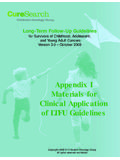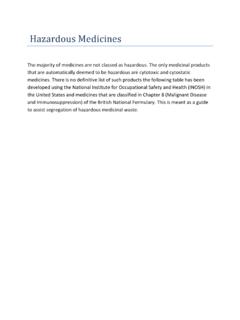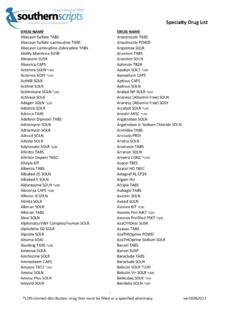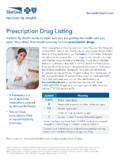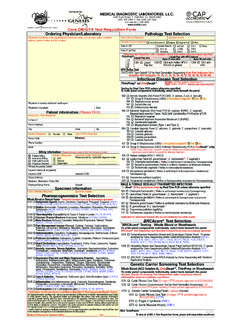Transcription of Appendix I Materials for Clinical Applications
1 Long-Term Follow-Up Guidelinesfor Survivors of Childhood, Adolescent, and Young Adult CancersVersion 2013 Copyright 2013 Children s Oncology GroupAll rights reserved worldwideAppendix IMaterials for Clinical ApplicationsCOG LTFU Guidelines 8 Page 2 Version October 2013 ContentsContentsReference Materials 3 Abbreviations4 Chemotherapy Agents7 Summary of Cancer Treatment8 Instructions9 Summary Form Template (Abbreviated)11 Summary Form Template (Comprehensive)12 Summary Form Key14 Patient-Specific Guideline Identification Tool23 Instructions24 Patient-Specific Guideline Identification Tool (version )25 Section Number Comparison COG LTFU Guidelines Version vs Reference Guide36 Contents37 Determining Applicability of Radiation Sections for Specific Patients Based on Exposure30 Radiation Dose Calculation Examples39 Radiation Fields Defined40 Radiation Fields by Anatomic Region41 Guideline Radiation Section Numbers by Anatomic Region42 Total Body Irradiation43 Skin, Bones, Soft Tissues44 Brain/Neuroendocrine Axis, Cranium, Face, Eye, Ear45 Oral Cavity46 Neck/Thyroid47 Breast48 Lungs49 Heart50 Spleen 51 Esophagus52 Liver53 Bowel54 Kidneys55 Bladder/Urinary Tract56 Female Reproductive System57 Male Reproductive System58 Musculoskeletal System (Growth Problems.)
2 Radiation-Induced Fracture)59 Musculoskeletal System (Scoliosis/Kyphosis)60 Long-Term Follow-Up Guidelinesfor Survivors of Childhood, Adolescent, and Young Adult CancersVersion 2013 Copyright 2013 Children s Oncology GroupAll rights reserved worldwideReference Materials COG LTFU Guidelines Reference Materials Page 4 Version October 2013 AbbreviationsAbbreviationsAbbreviationDe finitionAAP-CIDPA merican Academy of Pediatrics Committee on Infectious Disease Prevention ABRB rainstem auditory evoked responsesAFPA lpha fetoproteinACSA merican Cancer SocietyAHAA merican Heart AssociationA LTAlanine aminotransferaseASTA spartate aminotransferaseATMA taxia telangiectasia cancer susceptibility gene located on chromosome 11 AVNA vascular necrosisBAERB rainstem auditory evoked responsesBCNUC armustine BMDBone mineral
3 DensityBMIBody mass indexBRCA1 Breast cancer, early onset gene (cancer susceptibility gene located on chromosome 17)BRCA2 Breast cancer 2, early onset gene (cancer susceptibility gene located on chromosome 13)BUNB lood urea nitrogenCaCalciumCBCC omplete blood countCCGC hildren s Cancer GroupCCNUL omustineCD-4 Cluster of differentiation antigen associated with helper T lymphocyteCDCC enters for Disease ControlcGVHDC hronic graft versus host diseaseClChlorideCNSC entral nervous systemCO2 Carbon dioxideCOGC hildren s Oncology GroupCSFC erebral spinal fluidCTComputed tomographyCXRC hest radiographDESD iethylstilbestrolDEXADual energy x-ray absorptiometryDLCOD iffusion capacity of carbon monoxideDOED yspnea on exertionEBMTE uropean Group for Blood and Marrow TransplantECHOE chocardiogramEKGE lectrocardiogramEIAE nzyme immunoassayFAPF amilial adenomatous polyposisFNAFine needle aspirateFSHF
4 Ollicle stimulating hormoneGHGrowth hormoneGVHDG raft versus host diseaseCOG LTFU Guidelines Reference Materials Page 5 Version October 2013 AbbreviationsAbbreviationDefinitionGyGra yHBcAbHepatitis B core antibody HBsAgHepatitis B surface antigenHCTH ematopoietic cell transplantHCVH epatitis C virusHDLHigh-density lipoproteinsHIBH aemophilus influenza BHIVH uman immunodeficiency virusHNPCCH ereditary nonpolyposis colorectal cancerHPFHigh power fieldHPVH uman papilloma virusHRTH ormonal replacement therapyHzHertzIBDI nflammatory bowel diseaseKPotassiumI-131 Iodine 131 radioisotopeIQIntelligence quotientITIntrathecalIVIntravenousIVIGI ntravenous immunoglobulinKUBK idneys, ureters, bladder radiographLHLuteinizing hormoneMIBGI odine-131-meta-iodobenzylguanidineMgMagn esiumMOPPM echlorethamine, Oncovin, Procarbazine, PrednisoneMRIM agnetic resonance imagingMUGAM ultiple Gated Acquisition scanNaSodiumNCEPN ational Cholesterol Education ProgramNCHSN ational Center for Health StatisticsNF1 Neurofibromin 1 (neurofibromatosis)
5 Cancer susceptibility gene located on chromosome 17 NSAIDsNon-steroidal anti-inflammatory drugsOAEO toacoustic emissionsOCPOral contraceptive pillsPAPP apanicoulauPCRP olymerase chain reactionPFTsPulmonary function testsp53 Cancer susceptibility gene located on chromosome 17 associated with familial cancers POBy mouthPO4 PhosphatePRNAs neededPSAP rostate specific antigenQCTQ uantitative computed tomographyAbbreviations (cont)COG LTFU Guidelines Reference Materials Page 6 Version October 2013 AbbreviationsAbbreviationDefinitionQTcCo rrected QT interval RB1 Retinoblastoma gene cancer susceptibility gene located on chromosome 13 RBCRed blood cellRDAR ecommended daily allowanceRUQR ight upper quadrantSCUBASelf-contained underwater breathing apparatus SDStandard deviationSOBS hortness of breathT4 ThyroxineTBIT otal body irradiationTPNT otal parenteral nutritionTSHT hyroid stimulating hormoneU/AUrinalysisUSPSTFU nited States Preventive Services Task ForceVODVeno-occlusive diseaseVZIGV aricella zoster immunoglobulinAbbreviations (cont)
6 COG LTFU Guidelines Reference Materials Page 7 Version October 2013 Chemotherapy AgentsGeneric NameAdditional name (s)ClassificationAsparaginaseElspar Erwinia asparaginaseKidrolase L-asparaginaseOncaspar PEG-asparaginaseEnzymeBleomycinBlenoxane Anti-tumor antibioticBusulfanBusulfex BusulphanMyleran Alkylating agentCarboplatinCBDCAP araplatin Heavy metalCarmustineBCNUBiCNU Alkylating agentChlorambucilLeukeran Alkylating agentCisplatinCDDPC isplatinumPlatinol Heavy metalCyclophosphamideCPMC ytoxan Neosar Procytox Alkylating agentCytarabineAra-CCytosar Cytosar-U Cytosine arabinosideAntimetaboliteDacarbazineDTIC DTIC-Dome Non-classical alkylatorDactinomycinActinomycin-DCosmeg en Anti-tumor antibioticDaunorubicinCerubidine DaunomycinDaunoXome Anthracycline antibioticDexamethasoneDecadron
7 CorticosteroidDoxorubicinAdriamycin Doxil Rubex Anthracycline antibioticEpirubicinEllence Pharmorubicin PFS Anthracycline antibioticEtoposideVePesid VP-16 EpipodophyllotoxinIdarubicinIdamycin Anthracycline antibioticIfosfamideIfex Alkylating agentLomustineCeeNU CCNUA lkylating agentMechlorethamineMustargen Nitrogen MustardAlkylating agentMelphalanAlkeran Alkylating agentChemotherapy AgentsGeneric NameAdditional name (s)ClassificationMercaptopurine6-Mer captopurine6-MPPurinethol AntimetaboliteMethotextrateAmethopterinF olex Mexate Trexall AntimetaboliteMitoxantroneNovantrone Anthracycline antibioticPrednisoneDeltasone MethylprednisolonePrednisoloneCorticoste roidProcarbazineMatulane Natulan Alkylating agentTemozolomideTemodal Temodar Non-classical alkylatorTeniposideVM-26 Vumon EpipodophyllotoxinThioguanineLanvis Tabloid 6-Thioguanine6-TGAntimetaboliteThiotepaT hioplex Alkylating agentVinblastineVBLV elban Velbe Plant alkaloidVincristineOncovin VCRV incasar Vincrex Plant alkaloidLong-Term Follow-Up Guidelinesfor Survivors of Childhood, Adolescent.
8 And Young Adult CancersVersion 2013 Copyright 2013 Children s Oncology GroupAll rights reserved worldwideSummary of Cancer TreatmentCOG LTFU Guidelines Summary of Cancer Treatment Page 9 Version October 2013 InstructionsSummary of Cancer Treatment InstructionsImportance of a Comprehensive Cancer Treatment SummaryThe Children s Oncology Group Long-Term Follow-Up Guidelines for Survivors of Childhood, Adolescent, and Young Adult Cancers are based on therapeutic exposures received during cancer treatment. Availability of a comprehensive treatment summary, including all therapeutic agents received by the survivor, is presumed. Patients who do not have a comprehensive treatment summary should be instructed to obtain one from the institution(s) where they received their treatment.
9 Ideally, the comprehensive treatment summary should include the following information: Demographics ( name , sex, date of birth, contact information) Diagnosis, including site/stage, date, and relapse(s) if any Pertinent secondary diagnoses ( , second malignancy, Down syndrome) Treatment protocol information, if applicable All chemotherapy agents received during treatment (including route of administration for all agents, cumulative doses for alkylators, bleomycin, and anthra-cyclines, and designation of high dose versus standard dose for methotrexate and cytarabine). Cumulative doses for all other agents should be provided if available. Note: High dose methotrexate/cytarabine is defined as any single dose 1000 mg/m2.
10 Standard dose methotrexate/cytarabine is defined as all single doses < 1000 mg/m2. See Section 33 (male) or 34 (female) of Guidelines for anthracycline isotoxic dose-equivalent conversion. For doses in mg/kg, multiply by 30 to obtain equivalent dosing in mg/m2 (example: 2 mg/kg = 60 mg/m2). Radiation therapy summary, including field(s), laterality (if applicable), start/stop dates, number of fractions, dose per fraction, boost dose/location (if applica-ble), total dose (in Gy), and radiation type. Note: To convert cGy or rads to Gy, divide dose by 100 (example: 2400 cGy = 2400 rads = 24 Gy); for definition of radiation fields, see page 3 of the Radiation Reference Guide ( Appendix 1) Hematopoietic cell transplant(s), including type(s), date(s), conditioning regimen(s), and GVHD prophylaxis and/or treatment Surgical procedures, including date, site, and laterality if applicable Other therapeutic modalities ( , biologicals, systemic radiation) Significant complications/late effects with dates of onset/resolution Adverse drug reactions/allergiesMinimum Information Necessary to Generate Patient-Specific Guidelines.

